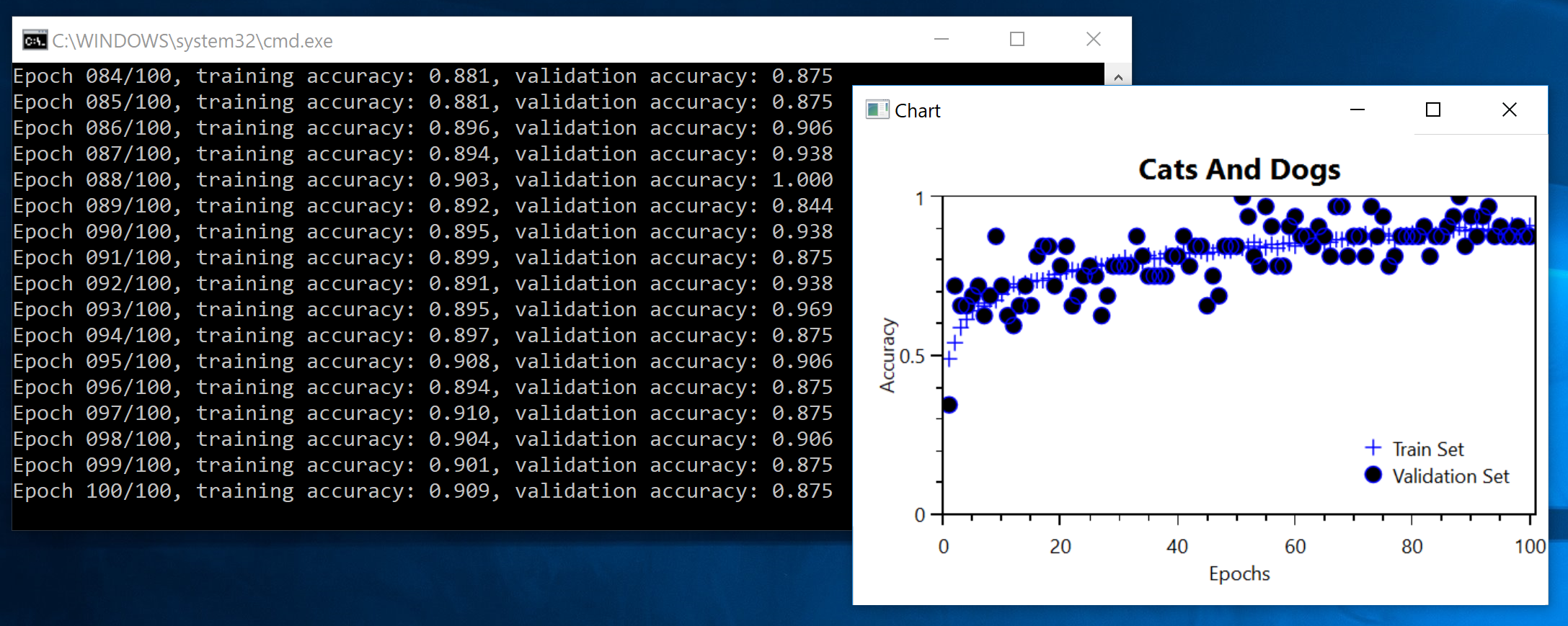The original Python code can be found in ch5-2.py
If you haven't read it yet, please go over Chapter 5.2 -- we'll not repeat the material here. Instead, we'll focus on the C# port.
The first thing that we need to do is to download the "cats and dogs" dataset, from https://www.kaggle.com/c/dogs-vs-cats/data. You'll need a Kaggle account for this, but if you are reading this, most probably you already have one :-).
Once you have downloaded the train.zip file, uncompress it, and it will look like
The Keras code uses an ImageDataGenerator.
train_generator = train_datagen.flow_from_directory(
# This is the target directory
train_dir,
# All images will be resized to 150x150
target_size=(150, 150),
batch_size=32,
# Since we use binary_crossentropy loss, we need binary labels
class_mode='binary')
validation_generator = test_datagen.flow_from_directory(
validation_dir,
target_size=(150, 150),
batch_size=32,
class_mode='binary')
With CNTK, we'll use a MinibatchSource. This is is done in the method
CNTK.MinibatchSource create_minibatchSource(string map_file, int num_classes, bool train) {
var transforms = new List<CNTK.CNTKDictionary>();
if (true) {
var randomSideTransform = CNTK.CNTKLib.ReaderCrop("RandomSide",
new Tuple<int, int>(0, 0),
new Tuple<float, float>(0.8f, 1.0f),
new Tuple<float, float>(0.0f, 0.0f),
new Tuple<float, float>(1.0f, 1.0f),
"uniRatio");
transforms.Add(randomSideTransform);
}
var scaleTransform = CNTK.CNTKLib.ReaderScale(image_width, image_height, num_channels);
transforms.Add(scaleTransform);
var imageDeserializer = CNTK.CNTKLib.ImageDeserializer(map_file, "labels", (uint)num_classes, "features", transforms);
var minibatchSourceConfig = new CNTK.MinibatchSourceConfig(new CNTK.DictionaryVector() { imageDeserializer });
return CNTK.CNTKLib.CreateCompositeMinibatchSource(minibatchSourceConfig);
}
Two things are worth pointing out:
First, the map_file is created by the method create_map_txt_files, and it has a very simple two-column format.
The first column is the full-path to the image, and the second column is the image class.
For example, the first few entries of the train_map.txt look like:
C:\Users\anastasios\Downloads\kagglecatsanddogs_3367a\PetImages\cat.0 0
C:\Users\anastasios\Downloads\kagglecatsanddogs_3367a\PetImages\dog.0 1
C:\Users\anastasios\Downloads\kagglecatsanddogs_3367a\PetImages\cat.1 0
C:\Users\anastasios\Downloads\kagglecatsanddogs_3367a\PetImages\dog.1 1
Second, we have used a
-
scaleTransformto resize the images so that can be fed into a 150x150x3 features tensor, -
randomSideTransformto augment the input images
CNTK provides also other types of ImageTransform
The Keras code to build the network is:
def build_network_with_dropout():
model = keras.models.Sequential()
model.add(keras.layers.Conv2D(32, (3, 3), activation='relu', input_shape=(150, 150, 3)))
model.add(keras.layers.MaxPooling2D((2, 2)))
model.add(keras.layers.Conv2D(64, (3, 3), activation='relu'))
model.add(keras.layers.MaxPooling2D((2, 2)))
model.add(keras.layers.Conv2D(128, (3, 3), activation='relu'))
model.add(keras.layers.MaxPooling2D((2, 2)))
model.add(keras.layers.Conv2D(128, (3, 3), activation='relu'))
model.add(keras.layers.MaxPooling2D((2, 2)))
model.add(keras.layers.Flatten())
model.add(keras.layers.Dropout(0.5))
model.add(keras.layers.Dense(512, activation='relu'))
model.add(keras.layers.Dense(1, activation='sigmoid'))
model.compile(loss='binary_crossentropy', optimizer=keras.optimizers.RMSprop(lr=1e-4), metrics=['acc'])
return model
In C#, we have:
void create_network() {
computeDevice = Util.get_compute_device();
features_tensor = CNTK.Variable.InputVariable(new int[] { image_height, image_width, num_channels }, CNTK.DataType.Float);
label_tensor = CNTK.Variable.InputVariable(new int[] { 2 }, CNTK.DataType.Float);
var scalar_factor = CNTK.Constant.Scalar<float>((float)(1.0 / 255.0), computeDevice);
network = CNTK.CNTKLib.ElementTimes(scalar_factor, features_tensor);
network = Util.Convolution2DWithReLU(network, 32, new int[] { 3, 3 }, computeDevice);
network = CNTK.CNTKLib.Pooling(network, CNTK.PoolingType.Max, new int[] { 2, 2 }, new int[] { 2 });
network = Util.Convolution2DWithReLU(network, 64, new int[] { 3, 3 }, computeDevice);
network = CNTK.CNTKLib.Pooling(network, CNTK.PoolingType.Max, new int[] { 2, 2 }, new int[] { 2 });
network = Util.Convolution2DWithReLU(network, 128, new int[] { 3, 3 }, computeDevice);
network = CNTK.CNTKLib.Pooling(network, CNTK.PoolingType.Max, new int[] { 2, 2 }, new int[] { 2 });
network = Util.Convolution2DWithReLU(network, 128, new int[] { 3, 3 }, computeDevice);
network = CNTK.CNTKLib.Pooling(network, CNTK.PoolingType.Max, new int[] { 2, 2 }, new int[] { 2 });
network = CNTK.CNTKLib.Dropout(network, 0.5);
network = CNTK.CNTKLib.ReLU(Util.Dense(network, 512, computeDevice));
network = Util.Dense(network, 2, computeDevice);
loss_function = CNTK.CNTKLib.CrossEntropyWithSoftmax(network.Output, label_tensor);
accuracy_function = CNTK.CNTKLib.ClassificationError(network.Output, label_tensor);
var parameterVector = new CNTK.ParameterVector((System.Collections.ICollection)network.Parameters());
var learner = CNTK.CNTKLib.AdamLearner(parameterVector, new CNTK.TrainingParameterScheduleDouble(0.0001, 1), new CNTK.TrainingParameterScheduleDouble(0.99, 1));
trainer = CNTK.CNTKLib.CreateTrainer(network, loss_function, accuracy_function, new CNTK.LearnerVector() { learner });
evaluator = CNTK.CNTKLib.CreateEvaluator(accuracy_function);
}
Note that the image pixel values are divided by 255 before they are fed into the network.
The Keras code is only one line
history = model.fit_generator(
train_generator,
steps_per_epoch=100,
epochs=100,
validation_data=validation_generator,
validation_steps=50)
With C#, we need to get the data from the MinibatchSource and feed them into the network for training.
double train_phase(CNTK.MinibatchSource reader) {
var featuresStreamInfo = reader.StreamInfo("features");
var labelsStreamInfo = reader.StreamInfo("labels");
var num_samples = 0;
var num_minibatches = 0;
var score = 0.0;
while (num_samples < epoch_size) {
num_minibatches++;
var minibatchData = reader.GetNextMinibatch(minibatch_size, computeDevice);
var arguments = new batch_t() { { features_tensor, minibatchData[featuresStreamInfo] }, { label_tensor, minibatchData[labelsStreamInfo] } };
num_samples += (int)(minibatchData[featuresStreamInfo].numberOfSamples);
trainer.TrainMinibatch(arguments, computeDevice);
score += trainer.PreviousMinibatchEvaluationAverage();
}
var result = 1.0 - (score / num_minibatches);
return result;
}
Once again, we'll fire up a WPF window with an OxyPlot chart.

